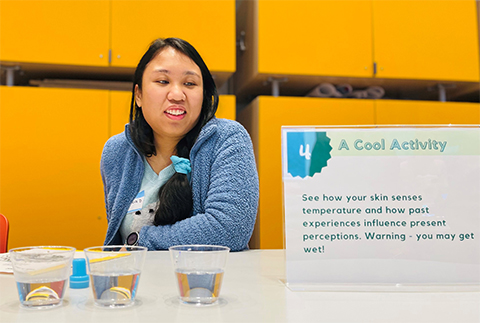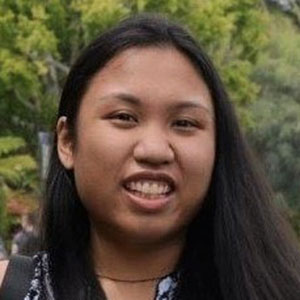
The teaching power of water
Sometimes, I volunteer for the science outreach organization BioBus. Their monthly Saturday Science events offer interactive activities for children related to the theme of the month.
A Saturday Science event in March focused on the body’s senses of smell, sight and touch. I looked at the activity stations around me and saw optical illusion flash cards and books, video simulations, a large set of spice jars and several microscopes.

Then I was assigned to my station: three plastic cups of water.
The cups held water at three different temperatures: hot, room-temperature and ice-cold. The children were to dip two fingers in the room-temperature water for 20 seconds, then in ice-cold water for 20 seconds, then back to the room-temperature water for 20 seconds. After the third dip, they’d say what they felt. If they were still interested, they could try again with hot water instead of cold.
The purpose of the activity was to experience how skin senses temperature and how past experiences influence present experiences. When children dipped their fingers in the cold water, their skin sensed this cold, and when they dipped their fingers back in the room-temperature water, they would feel a warm sensation at their fingertips — a quick, kid-friendly way to demonstrate body temperature regulation.
“Oh, that’s simple enough,” I thought. “It’ll be a short, one-minute activity.”
I questioned whether children would be very interested in this exercise; there wasn’t much to it.
Sure enough, the first child looked bored, and I could tell he wanted to move on. His mom, who was watching him, even remarked, “That’s it?”
The next few children behaved in a similar way; they took one minute to complete the first part of the activity, obtained their completion stamp and quickly moved on to the other stations.
But as the event went on, I found that some children were taking longer at my station. Instead of just stopping after the cold water, they stayed to try the exercise with hot water. Many were eager and excited to put their fingers in the cups. One girl’s face lit up like a Christmas tree as soon as she felt the temperature difference at the third dip.
Some were also curious about what else they could try. One child put one finger in the cold water and one finger in the hot water at the same time. A few children were so amazed with the water activity that they brought their friends to the station to try the exercise and then did it again themselves. What seemed like a simple and quick activity turned out to be popular with the kids.
I recently learned that this water activity has been a station at many past Saturday Science events under slightly different names to match the themes. It never fails to garner interest. And after manning this station, I understand why.
Water may be a simple molecule, and sometimes you don’t think much of it. But water really is an effective teacher.
Read more
Read more articles and essays about our ASBMB Molecule of the year.
Water, you say? Sephra Rampersad recalls a great scientist asking, what is the one critical component that could make or break your experiment in any lab?
Water takes center stage Danielle Guarracino remembers the role water played at two moments in her life, one doing scary experiments and one facing a health scare.
What I’ve learned about water, aging and protein quality control Alice Liu thought an increase in heat shock protein chaperones would prevent misfolding in Huntington’s disease proteins. The results surprised her, and water was the key.
The subtle strength of hydrogen bonds Indu Sridharan remembers how water complicated her atomic force microscopy imaging studies of collagen.
Water rescues the enzyme “Sometimes you must bend the rules to get what you want.” In the case of using water in the purification of calpain-2, Dorothy Croall writes, it was worth the risk.
There are worse things in the water than E. coli E. coli levels determined whether Olympic swimmers could dive into the Seine this past summer. But are these bacteria the best proxy for water contamination? Andrea Luis investigates.
Molecular impressions of water as cuneiform cascade Inspired by "the most elegant depiction of H2O’s colligative features," Thomas Gorrell created a seven-tiered visual cascade of Sumerian characters beginning with the ancient sign for water.
Virtual issue celebrates water in ASBMB journals Check out a dozen gold open-access articles covering exciting research about the society’s 2024 Molecule of the Year.
Enjoy reading ASBMB Today?
Become a member to receive the print edition four times a year and the digital edition monthly.
Learn moreGet the latest from ASBMB Today
Enter your email address, and we’ll send you a weekly email with recent articles, interviews and more.
Latest in Opinions
Opinions highlights or most popular articles

Debugging my code and teaching with ChatGPT
AI tools like ChatGPT have changed the way an assistant professor teaches and does research. But, he asserts that real growth still comes from struggle, and educators must help students use AI wisely — as scaffolds, not shortcuts.

AI in the lab: The power of smarter questions
An assistant professor discusses AI's evolution from a buzzword to a trusted research partner. It helps streamline reviews, troubleshoot code, save time and spark ideas, but its success relies on combining AI with expertise and critical thinking.

How AlphaFold transformed my classroom into a research lab
A high school science teacher reflects on how AI-integrated technologies help her students ponder realistic research questions with hands-on learning.

Writing with AI turns chaos into clarity
Associate professor shares how generative AI, used as a creative whiteboard, helps scientists refine ideas, structure complexity and sharpen clarity — transforming the messy process of discovery into compelling science writing.

Teaching AI to listen
A computational medicine graduate student reflects on building natural language processing tools that extract meaning from messy clinical notes — transforming how we identify genetic risk while redefining what it means to listen in science.

What’s in a diagnosis?
When Jessica Foglio’s son Ben was first diagnosed with cerebral palsy, the label didn’t feel right. Whole exome sequencing revealed a rare disorder called Salla disease. Now Jessica is building community and driving research for answers.

